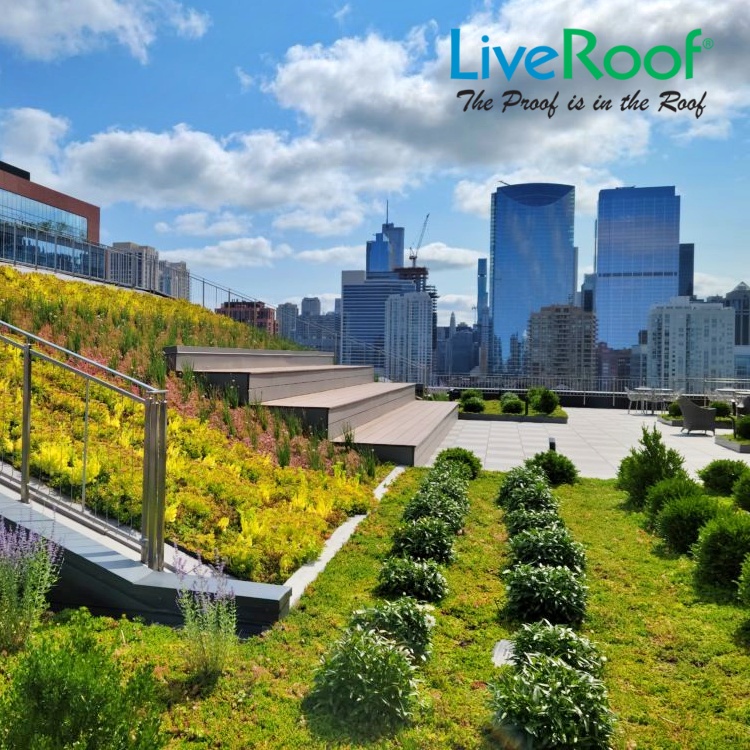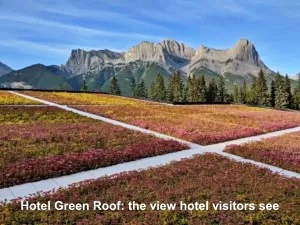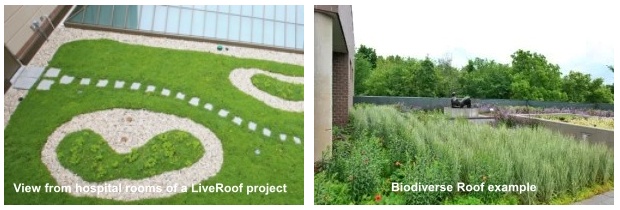By Doni Burton, business development manager for LiveRoof Global — 17 years ago, LiveRoof, LLC. developed the LiveRoof Hybrid Green Roof System, touted as the only green roof solution installed with fully mature plants thriving in a healthy, connected ecosystem from day one of installation. LiveRoof projects often become signature elements on commercial, public, university, school and hospital buildings all over the US and Canada.
As LiveRoof celebrates its 17th year, we are doing so with a year-long theme: Why do a Green Roof? Specifically, we will focus on the benefits of green roofs, and how they enhance our lives and the environment. Please enjoy this overview addition that focuses on the overarching benefits of green roofs!
Can I afford a green roof?
This is a compelling question. Green roofs typically cost more than traditional roofs to acquire, so why spend the extra money? There are at least 20 reasons to do a green roof, but let’s start with five strictly financial reasons, which will pay for the green roof (over and over).
Financial benefits and return on investment
Traditional roofs have a lifespan of 20 years and fail due to degradation from ultraviolet light, loss of plasticity from drying winds, and micro tearing from repeated heating and cooling cycles. A green roof provides protection from environmental exposure, which extends the life of the roof 6o years or more, thus avoiding at least two expensive re-roofing events. Energy conservation is another financial benefit, as green roofs can save up to 25% on energy costs. These two benefits alone can pay for a green roof within 20 years.
In addition, increased building density is often allowed when buildings have green roofs, as building codes typically acknowledge green roofs as “green space” and as a means to reduce stormwater runoff. What this means is more rentable or sellable space on the building site, and this is financially important especially with the high cost of land in urban settings.
Buildings with green roofs tend to sell or rent for higher prices as well, and this has been proven to pay for the green roof upon initial sale in some instances. Green roofs can also play a partnership role with solar, and because of the cooling effect of the green roof, the solar panels operate more efficiently and can increase solar output 5-15%.
Municipal/societal benefits
Green roofs help lower water infrastructure costs and protect water resources. During heavy rain events the amount of rain can be more than the city’s sewage processing infrastructure can handle, and combined sewage overflows can occur. Green roofs absorb and evaporate water (often 50% or more annually) and therefore lessen the demands on sewage treatment systems. This allows municipalities to operate with smaller and less costly sewage treatment facilities.
Another municipal/societal benefit is reduced noise. Green roofs act as a sound absorber, and when multiple green roofs are installed in a given area within the city, the impact of the noise reduction is experienced by the entire community. Finally, green roofs create installation and maintenance jobs, which in turn supports the community.
Environmental impacts
Green roofs help with carbon sequestration. This is because plants conduct photosynthesis, and in the process pull carbon dioxide from the air and store it in their leaves and roots as components of starches and sugars. Further, green roofs provide thermal insulation benefits which can reduce the need for heating and cooling, further reducing carbon emissions.
A study in Germany showed green roofs also contribute to mitigating urban heat islands — artificially hot zones caused when hard surfaces like asphalt, concrete, brick and metal (and a lack of vegetation), heat up the city. Heat islands cause air currents and stir up dust exacerbating allergies and asthma.
Another environmental benefit of green roofs is cooling and filtering rainwater (before it ends up in waterways). This is important for the preservation of aquatic plants and animals. Finally, all green roofs and particularly biodiverse green roofs provide habitat for invertebrates, birds and endangered plants. The city of Toronto has developed biodiverse guidelines to encourage and support the development of more biodiverse green roofs. The hope is to restore biodiverse ecosystems roof by roof.
Human wellness
In recent years we have a deeper appreciation for “biophilia,” whereby scientists can measure the positive impact nature has upon our physical and psychological wellness. Reductions in stress hormones are easily measured, and stress-reducing benefits are now associated with green roofs as well as constructed landscapes and natural areas. People experience better overall well-being after visiting or even viewing a green space.
Toronto hospitals follow green roof mandates for this reason (as well as the myriad of other benefits of green roofs). Their codes state that all roofs that are viewable from hospital rooms must have green roofs. In doing so, Toronto hospitals are using green roofs to reduce patient healing times and improve overall patient well-being.
Children also learn better when they have a view of nature and chances to interact with green spaces. Schools that install green roofs with amenity decks or walking paths create spaces for students to view nature while learning.
Another human wellness area addressed by green roofs is public art and aesthetics. The beauty and the “views” of green roofs are other solid reasons for implementing green roofs, as beauty and aesthetics are associated with greater positive social interaction. In Massachusetts, they even adopted an ordinance to protect the “views” of the green roofs and green walls for a nearby Museum.
Lastly, green roofs support food justice security (in a “food-just” world people are able to grow, purchase, and store their own food), with rooftop farms generating jobs and providing food for local communities.
In closing
I started this article with the question “Why do a Green Roof?” As it turns out, there are at least 20 reasons why green roofs are a wise choice from the financial, municipal/societal, environmental, and human wellness perspectives. We can change the world for the better one green roof at a time and in doing so, create a better tomorrow. If we want to have an impact on the environment that is positive, look to green roofs. Green roofs make a difference for a better world and future generations. We can do it “up on a roof.”
About this piece
LiveRoof Feature stories publish quarterly with the goal in mind to showcase the values of our purpose-driven network. This year’s theme is “Why do a Green Roof?” This is the first feature story in the series. Contact Doni Burton at doni@liveroof.com with any comments or questions.
About the company
Based in Spring Lake, Michigan, LiveRoof Global, LLC is a top horticultural science company in the green roof industry. The LiveRoof Hybrid Green Roof System is a proven green roof system. LiveRoof establishes a healthy, sustainable ecosystem covering rooftops with seamless vegetation. Licensed regional growers customize plant selection for every LiveRoof project. They deliver the system’s modules abundantly vegetated with locally cultivated, full-grown plants for an instant green roof and trouble-free ownership.
About the author
Doni Burton is the business development manager for LiveRoof Global. Her main responsibility as business development manager is working with LiveRoof Global Growers and their customers. Burton completed her doctor of education in 2019, and most of her career was in educational administration. She also taught for many years as a university professor, but says that working at LiveRoof has taught her about the incredible benefits provided by green roofs. Burton’s hope is that this series of interviews and stories will nurture the environmental and horticultural interests of each reader.







